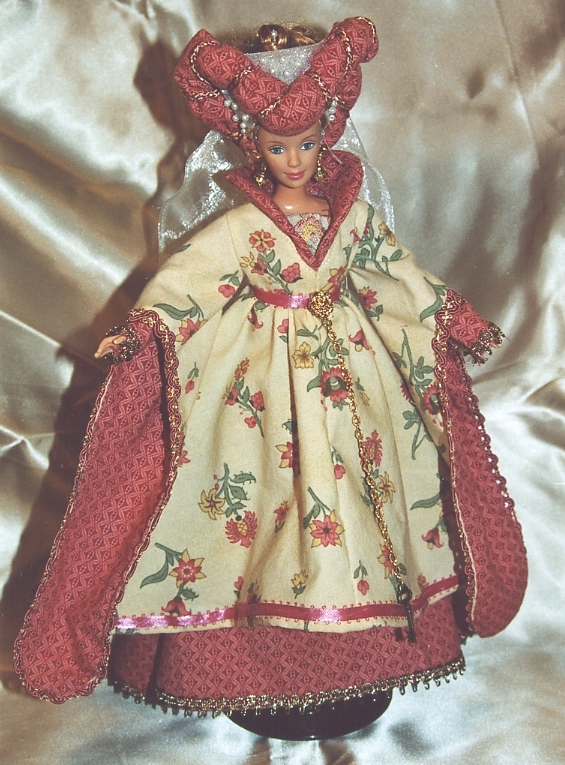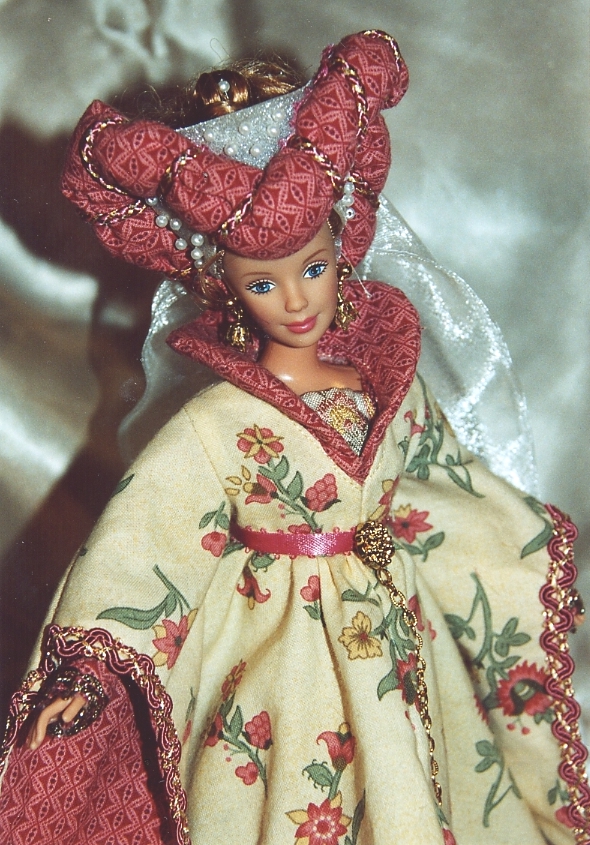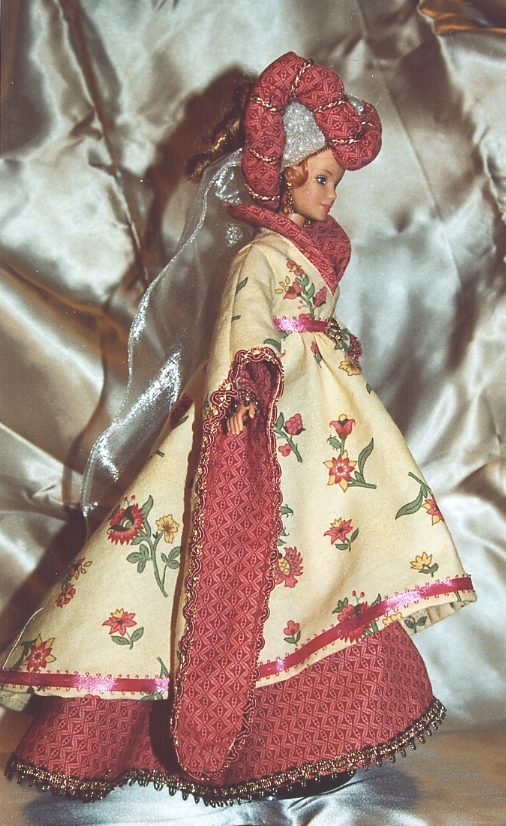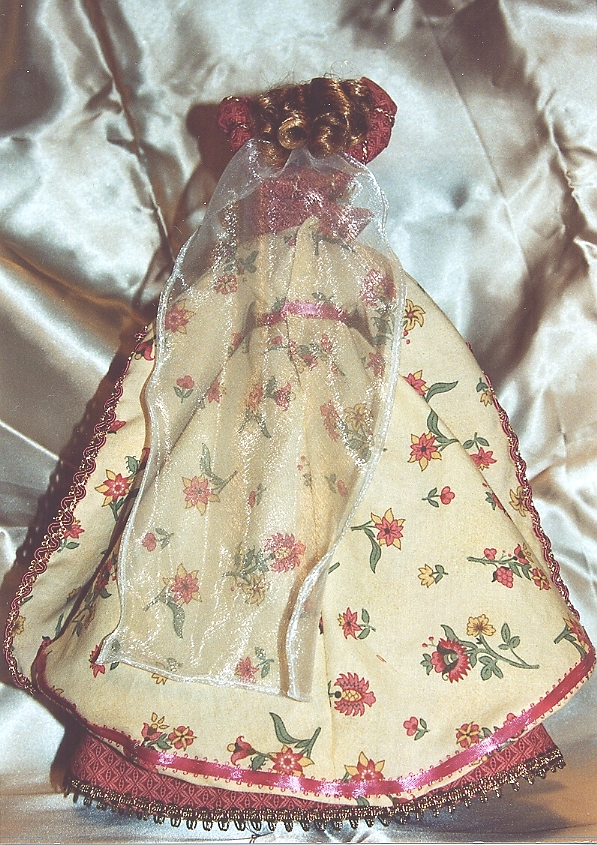 |
 |
 |
 |
 |
 |
 |
|
| Isabel |
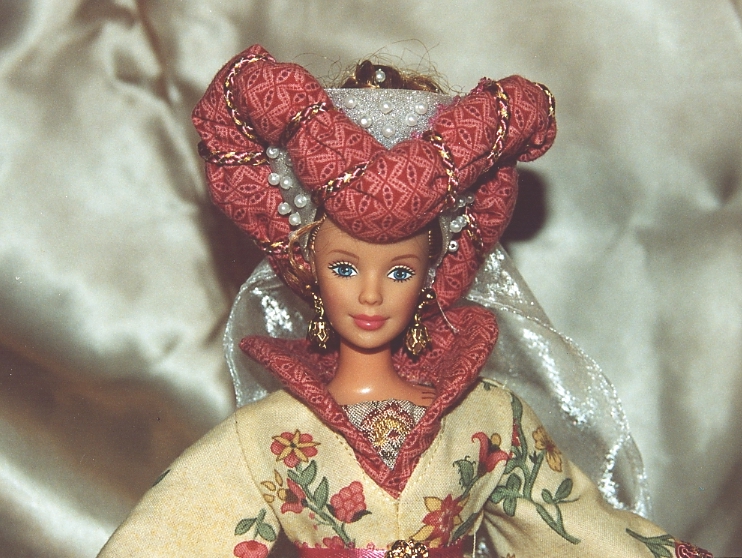
|
This design represents a fashionable noblewoman of the 1420's Here is the historical milieu: Henry V of England (of Shakespeare's
famous play and the Battle of Agincourt) and Charles VI of France died in 1422, and were succeeded by their sons, Henry VI
and Charles VII, who continued the campaigns of the Hundred Years' War; Joan of Arc was instrumental in the turning of the
tide against the English in 1429.
| Isabel |

|
| Side View of Heart-Shaped Headdress |

|
| reconstructed from an illustration in the Bedford Book of Hours, 1423 |
The style of dress changed very subtly throughout the 15th century, but headdresses had never been larger or more varied and
elaborate. The one employed in this design is called the "heart-shaped headdress" for obvious reasons. (For examples
of another popular style, the "hennin" or "steeple" hat see the Medievale Autumnale and Briar Rose dolls.)
A stiffened roll of fabric formed the two sweeping "wings" of the headdress, with more sheer network filling in
the sides and top, all would be richly trimmed with gold and jewels. Here the rolls of the headdress are wired and padded
for shape, covered in the same material as the underdress and wrapped with rose and gold rope; translucent ivory netting fills
in the rest which is studded with "pearls". (In reality all the hair would be inside the headdress, but rather
than cover this doll's beautiful strawberry-blond hair I have left it open at the back showing an arrangement of curls, some
fastened with "pearl"-tipped hairpins–a little curl escapes the side of the headdress as well. At the
base of the headdress is an attached ivory veil.
|
 |
|
 |
 |
 |
|
|
|
 |
 |
 |
 |
 |
 |
 |

| Isabel |

|
The fashionable overdress of the day, called a "houpeland," is marked by its long, dragging sleeves and high waist,
v-neck and wide collar. The fabric of the houpeland is another fabulous "Morris-style" print I found which closely
copied medieval and renaissance textile design. Late medieval textiles for both upholstery and clothing favored rich colors
and bold, large prints in stylized geometric and floral patterns. Here stylized flowers in rose and yellow with green foliage
fall upon a butter-yellow background; the rose-colored material of the underdress is repeated in the lining of the trailing
sleeves and the upstanding collar. Gold and rose braid edge the sleeves while rose-colored ribbon trims the hem and forms
the belt. The belt "buckle" is a stylized golden flower.
| Isabel |

|
The underdress, called at the time a 'cotehardie' or 'kyrtle', is rose colored with a geometric print; the sleeves are long
and tight, the bodice fitted to the hips, and the skirt full, cut in a train in back. The hem, waist, and cuffs are trimmed
with gold and rose braid, while the bodice has an wide accent ribbon of embroidered roses.
|
|
 |
 |
 |
|
| Isabel |

|
A gold-chain "chatelaine" hangs from the belt buckle. The "chatelaine," taken from the French word for
"mistress of the castle," was worn by the lady of the house to keep important things safe and at hand–it
often held a purse and/or keys. Lady Isabel carries a key to the family's treasure box or the pantry where foodstuffs and
the silver plate were kept.

This illustration is a reconstruction from the Bedford Book of Hours presented to Anne, Duchess of Bedford by her nephew,
King Henry VI in 1430--apparently reproducing something she wore in 1423.
|
|
 |
 |
 |





